动词不定式用法大全
动词不定式的用法
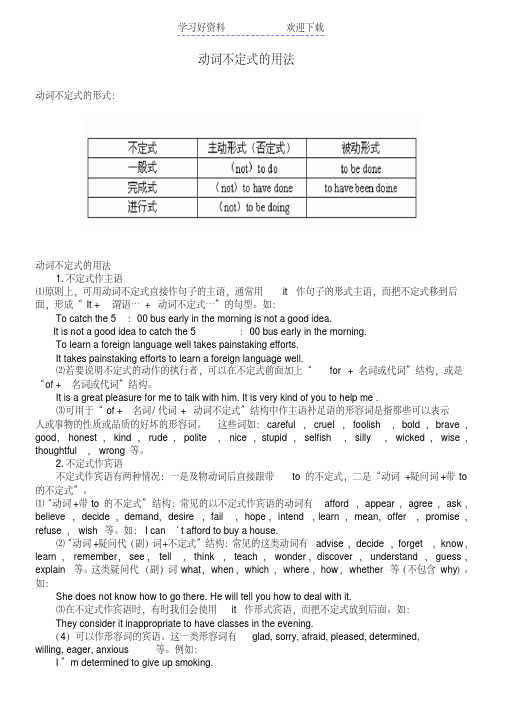
动词不定式的用法动词不定式的形式:动词不定式的用法1.不定式作主语⑴原则上,可用动词不定式直接作句子的主语,通常用it作句子的形式主语,而把不定式移到后面,形成“It + 谓语… + 动词不定式…”的句型。
如:To catch the 5:00 bus early in the morning is not a good idea.It is not a good idea to catch the 5:00 bus early in the morning.To learn a foreign language well takes painstaking efforts.It takes painstaking efforts to learn a foreign language well.⑵若要说明不定式的动作的执行者,可以在不定式前面加上“for + 名词或代词”结构,或是“of + 名词或代词”结构。
It is a great pleasure for me to talk with him. It is very kind of you to help me .⑶可用于“of + 名词/代词 + 动词不定式”结构中作主语补足语的形容词是指那些可以表示人或事物的性质或品质的好坏的形容词。
这些词如:careful, cruel, foolish, bold, brave,good, honest, kind, rude, polite, nice,stupid, selfish, silly, wicked, wise,thoughtful, wrong等。
2.不定式作宾语不定式作宾语有两种情况:一是及物动词后直接跟带to的不定式,二是“动词+疑问词+带to 的不定式”。
⑴“动词+带to的不定式”结构:常见的以不定式作宾语的动词有afford, appear, agree, ask,believe, decide, demand, desire, fail, hope, intend,learn, mean, offer, promise,refuse, wish等。
动词不定式的用法大全
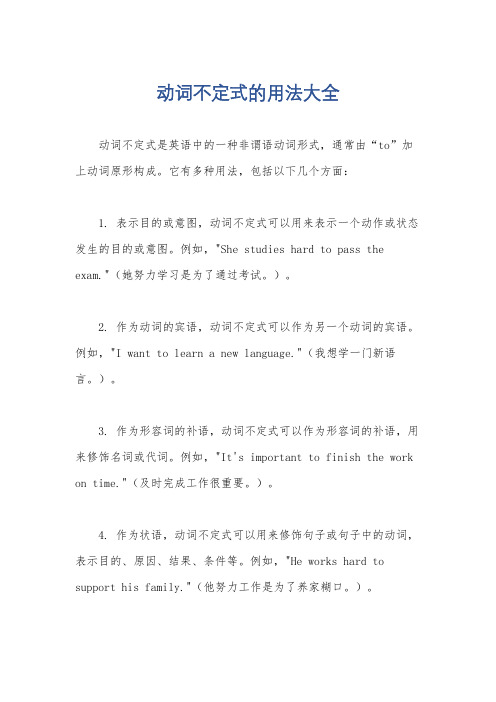
动词不定式的用法大全动词不定式是英语中的一种非谓语动词形式,通常由“to”加上动词原形构成。
它有多种用法,包括以下几个方面:1. 表示目的或意图,动词不定式可以用来表示一个动作或状态发生的目的或意图。
例如,"She studies hard to pass the exam."(她努力学习是为了通过考试。
)。
2. 作为动词的宾语,动词不定式可以作为另一个动词的宾语。
例如,"I want to learn a new language."(我想学一门新语言。
)。
3. 作为形容词的补语,动词不定式可以作为形容词的补语,用来修饰名词或代词。
例如,"It's important to finish the work on time."(及时完成工作很重要。
)。
4. 作为状语,动词不定式可以用来修饰句子或句子中的动词,表示目的、原因、结果、条件等。
例如,"He works hard to support his family."(他努力工作是为了养家糊口。
)。
5. 与情态动词连用,动词不定式可以与情态动词连用,表示不同的情态含义,如推测、必要性、可能性等。
例如,"You should study harder to improve your grades."(你应该更努力学习来提高成绩。
)。
6. 作为主语,动词不定式有时可以作为句子的主语。
例如,"To travel around the world is my dream."(环游世界是我的梦想。
)。
总的来说,动词不定式在句子中具有多种用法,可以表示目的、作为宾语、形容词的补语、状语、与情态动词连用,甚至可以作为句子的主语。
掌握动词不定式的用法对于准确理解和运用英语语法至关重要。
希望这些信息能够帮助你更好地理解动词不定式的用法。
动词不定式时态的用法

动词不定式时态的用法动词不定式是一种非谓语动词形式,由“to +动词原形”构成。
它具有名词、形容词和副词的特征,在句子中可以充当主语、宾语、定语、状语、宾语补足语等成分。
动词不定式的时态有一般式、进行式、完成式和完成进行式,下面我们来详细了解一下它们的用法。
一、一般式(to do)动词不定式的一般式表示的动作通常与谓语动词的动作同时发生或在其后发生。
1、表示将来的动作例如:“I have a lot of work to do tomorrow”(明天我有很多工作要做。
)这里的“to do”表示将来要做的工作。
2、用于某些动词后作宾语常见的这类动词有:want, hope, wish, decide, plan, expect 等。
比如:“She wants to buy a new dress”(她想买一件新裙子。
)3、作定语“There is nothing to worry about”(没什么可担心的。
)“to worry about”修饰“nothing”,表示“可担心的事情”。
4、目的状语“We come here to learn English”(我们来这里是为了学英语。
)“to learn English”表示来这里的目的。
二、进行式(to be doing)动词不定式的进行式表示的动作与谓语动词的动作同时进行。
例如:“He seems to be waiting for someone”(他似乎在等什么人。
)“to be waiting”与“seems”同时发生。
这种形式用得相对较少,通常在某些特定的语境中使用,以强调动作正在进行。
三、完成式(to have done)动词不定式的完成式表示的动作发生在谓语动词之前。
1、表示过去未曾实现的愿望、打算或计划比如:“I intended to have written to you, but I was too busy”(我本打算给你写信的,但我太忙了。
动词不定式的用法总结及例句
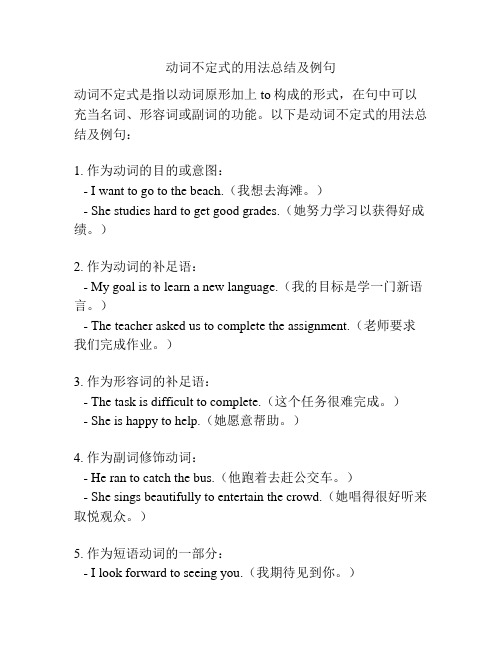
动词不定式的用法总结及例句动词不定式是指以动词原形加上to构成的形式,在句中可以充当名词、形容词或副词的功能。
以下是动词不定式的用法总结及例句:1. 作为动词的目的或意图:- I want to go to the beach.(我想去海滩。
)- She studies hard to get good grades.(她努力学习以获得好成绩。
)2. 作为动词的补足语:- My goal is to learn a new language.(我的目标是学一门新语言。
)- The teacher asked us to complete the assignment.(老师要求我们完成作业。
)3. 作为形容词的补足语:- The task is difficult to complete.(这个任务很难完成。
)- She is happy to help.(她愿意帮助。
)4. 作为副词修饰动词:- He ran to catch the bus.(他跑着去赶公交车。
)- She sings beautifully to entertain the crowd.(她唱得很好听来取悦观众。
)5. 作为短语动词的一部分:- I look forward to seeing you.(我期待见到你。
)- He decided to give up smoking.(他决定戒烟。
)6. 作为动词的主语:- To live a healthy lifestyle is important.(过健康的生活方式很重要。
)- To travel the world is his dream.(环游世界是他的梦想。
)7. 作为动词的宾语:- I like to read novels.(我喜欢读小说。
)- They want to visit their grandparents.(他们想去拜访祖父母。
)需要注意的是,动词不定式在句中的位置可以灵活变化,但通常放在动词之后、名词之前、或者作为句子的结尾。
动词不定式6种用法
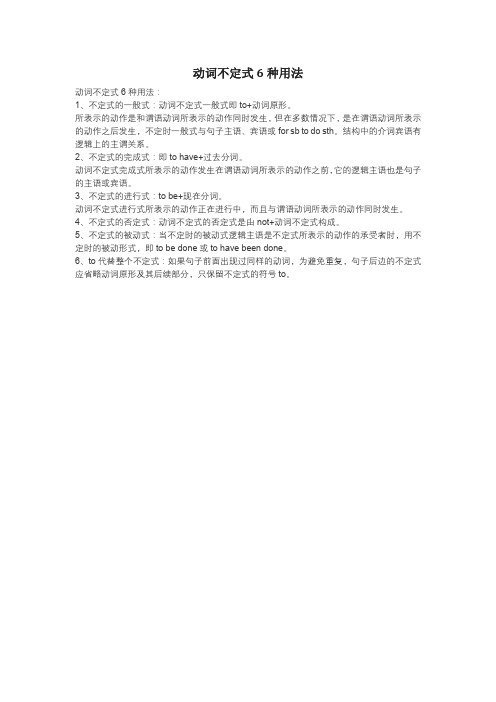
动词不定式6种用法
动词不定式6种用法:
1、不定式的一般式:动词不定式一般式即to+动词原形。
所表示的动作是和谓语动词所表示的动作同时发生,但在多数情况下,是在谓语动词所表示的动作之后发生,不定时一般式与句子主语、宾语或for sb to do sth。
结构中的介词宾语有逻辑上的主谓关系。
2、不定式的完成式:即to have+过去分词。
动词不定式完成式所表示的动作发生在谓语动词所表示的动作之前,它的逻辑主语也是句子的主语或宾语。
3、不定式的进行式:to be+现在分词。
动词不定式进行式所表示的动作正在进行中,而且与谓语动词所表示的动作同时发生。
4、不定式的否定式:动词不定式的否定式是由not+动词不定式构成。
5、不定式的被动式:当不定时的被动式逻辑主语是不定式所表示的动作的承受者时,用不定时的被动形式,即to be done或to have been done。
6、to代替整个不定式:如果句子前面出现过同样的动词,为避免重复,句子后边的不定式应省略动词原形及其后续部分,只保留不定式的符号to。
动词不定式的用法总结

动词不定式的用法总结
1.作为句子的主语:
Ex: To study English is important for success.
2.作为句子的宾语:
Ex: I want to learn how to play the guitar.
3.作为动词的宾语补语:
Ex: She found it difficult to understand the instructions.
4.与一些动词连用,构成特定的动词短语:
Ex: I need to go to the store.
He wants to buy a car.
5.作为目的状语,表示动作的目的或意图:
Ex: He went to the library to study.
6.作为结果状语,表示结果或后果:
Ex: She studied hard to pass the exam.
7.作为方式状语,表示动作的方式或方法:
Ex: He walked slowly to avoid falling.
8.与形容词连用,表示主语的特征或状态:
Ex: She is happy to see her friends.
9.与副词连用,表示副词的程度或程度的变化:
Ex: He tried to be more careful.。
动词不定式用法大全

动词不定式用法大全动词不定式用法大全英语动词的非谓语形式为三种:动词不定式、动名词和分词。
非谓语动词没有人称和数的变化。
动词不定式是一种非谓语动词形式,其结构为“to+动词原形”,其中to 不是介词,而是动词不定式的符号,称为小品词,动词不定式没有人称和数的变化。
动词不定式和其后面的名词等构成不定式短语,在句子中可以用作主语、表语、宾语、补足语、定语、状语等。
一. 作主语例如:To be a doctor is hard. 做医生很难。
To learn English well is not easy. 学好英语不容易。
To say is to believe.眼见为实。
动词不定式(短语)作主语时,为了避免句子的头重脚轻,可以用“it”作形式主语,而把真正的主语--动词不定式(短语)放在句子的后部。
例如上面的句子可以表示为:It is hard to be a doctor.It is not easy to learn English well. 再如:It’s important to plant trees in spri ng.如果动词不定式的动作是谁做的,可以在动词不定式前面加一个由介词for引导的短语,称为不定式的复合结构。
例:It’s good for us to read English aloud in the morning.对我们来说每天早晨大声读英语是很有益的。
It is important for students to use English every day.对学生来说每天使用英语是很重要的。
二. 作表语:(在形式上,位于系动词后的就是表语。
从含义上讲,表语是回答主语“是什么”或“怎么样”的语法成分。
)动词不定式(短语)作表语常用于系词be的后面。
例:His work is to drive a car. 他的工作是开车。
My job is to feed animals. 我的工作是饲养动物。
动词不定式的用法大全

动词不定式的用法大全今日一起学习动词不定式的用法大全?快来一起学习吧。
下面我就和大家共享,来观赏一下吧。
动词不定式的用法大全一、动词不定式是什么?简洁来说:to do,非谓语动词形式之一二、位置?须位于被其修饰的名词或代词之后如:Is this the best way to help him?三、作用?具出名词,形容词,和副词的作用四、在句中可做的成分?除了不行做谓语外,其他成分都可以充当如:主语,宾语,定语,表语,宾补,状语(目的,结果,缘由)例句:1.To see is tobelieve.眼见为实/百闻不如一见。
(做主语)2. I wish to be sentto work in the country. (做宾语)3. Can you tell me which is the car to be repaired (做定语)4. My work is to clean the room every day. (做表语)5. He went to the hospital to be examined . (做目的状语)6. I don’t think it rightto do it that way. (做宾补)留意:英语中为了避开头重脚轻(说白了就是平衡句子结构的需要),往往to do一般用it作形式主语(It+be+形容词/名词词组+to do sth/ that)如:To help each other is good. =It is good to help each other .这句话的主语是老师标紫色的字体。
五、不定式的用法1.不定式常可用来修饰人也可以修饰物,表示已经将要发生的动作。
如:(1)He was the first guest to arrive. 他是第一个到达的客人。
(2)He was a brave man to do what he did.他是个勇者才有这样的行为。
动词不定式的用法及归纳
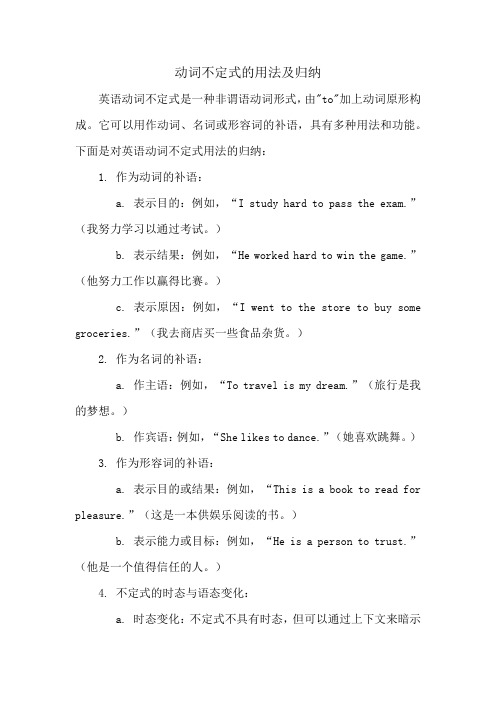
动词不定式的用法及归纳英语动词不定式是一种非谓语动词形式,由"to"加上动词原形构成。
它可以用作动词、名词或形容词的补语,具有多种用法和功能。
下面是对英语动词不定式用法的归纳:1. 作为动词的补语:a. 表示目的:例如,“I study hard to pass the exam.”(我努力学习以通过考试。
)b. 表示结果:例如,“He worked hard to win the game.”(他努力工作以赢得比赛。
)c. 表示原因:例如,“I went to the store to buy some groceries.”(我去商店买一些食品杂货。
)2. 作为名词的补语:a. 作主语:例如,“To travel is my dream.”(旅行是我的梦想。
)b. 作宾语:例如,“She likes to dance.”(她喜欢跳舞。
)3. 作为形容词的补语:a. 表示目的或结果:例如,“This is a book to read for pleasure.”(这是一本供娱乐阅读的书。
)b. 表示能力或目标:例如,“He is a person to trust.”(他是一个值得信任的人。
)4. 不定式的时态与语态变化:a. 时态变化:不定式不具有时态,但可以通过上下文来暗示时间关系。
b. 语态变化:不定式可以通过添加"be"动词的相应形式来表示被动语态。
例如,“He wants to be invited to the party.”(他希望被邀请参加派对。
)总之,不定式在句子中扮演着多种角色,并且具有多种用法和功能,具体使用取决于上下文和意图。
动词不定式的基本用法归纳

He is looking for a room to live in.
He is said the best way to travel by is on foot.
6.作状语
不定式作状语时,可表示目的,原因,结果或条件. 如; I’m very glad to hear the news. 原因 不定式作目的状语时,常可与to, to order to, so as to
1、不定式与被修饰的名词往往构成逻辑上的关系.如 名词为不定式的逻辑主语,构成主谓关系; 若名词 为逻辑宾语,则构成动宾关系;
He is not a man to tell lies.
There will not be enough space to stand in on the earth 2、作定语的不定式与所修饰的名词之间是动宾关系, 不定式动词又是不及物动词时,应在该动词上加上一 个介词,如;
I saw him play in the park.
→He was seen to play in the park.
The boss made those men work day and night.
→Those men were made to work day and night.
5.定语
All I want to do now What I want to do now is fill my stomach.
4.作宾语补足语
注意在感官动词see, hear, feel, listen to , notice, watch, observe等和使役动词let, have, make 后的 补足语中,不定式不带to.但这类句子变成被动语 态时,必须带to.
动词不定式的语法总结

动词不定式的语法总结动词不定式是非谓语动词的一种形式,是英语中常见的一种语法,学生一定要做好总结,拿下这个知识点。
小编为大家力荐了动词不定式常用的语法总结,给大家作为参考,欢迎阅读!动词不定式的七种用法动词不定式的基本形式为to+动词原形.1.动词不定式做主语.谓语用第三人称单数形式.如果主语较长则用it做形式主语,将真正的主语动词不定式放到句尾.egTo see is to believe.It's a bad habit to run after dinner.2 做表语.the important things is to save lives.3 做宾语he likes to play with children.4做宾语补足语.形容词做宾补时.常用it做形式宾语.把真正的宾语放到宾补之后.he feels it happy to help others.5做定语she asked me to help her with her English.6做状语you are never too old to learn.(结果状语)7特殊疑问词+动词不定式.I am thinking about what to say.动词的不定式的用法口诀①不定式有标记,to与动词连一起。
②没有人称数变化,动词特点它具备。
③主宾定状表补语,唯独作谓不可以。
④not 加上不定式,否定结构要牢记。
⑤疑问词与不定式,构成短语有意义。
⑥仔细推敲多思考,准确判断有依据。
动词不定式专题练习1. This company was the first ____ portable radios as well as cassette tape recorders in the world.A. producingB. to produceC. having producedD. produced2. The purpose of new technology is to make life easier, ____it more difficult.A .not making B. not make C .not to make D. nor to make3. Helen had to shout ______above the sound of the music .A .making herself hear B. to make herself hearC. making herself heard D .to make herself heard4. I don’t know whether you happen_______ ,but I am going to study in the U.S.A this September.A .to be heard. B. to be bearing C .to hear D .to have heard5. The news reporters hurried to the airport, only ______the film stars had left.A .to tellB .to be toldC .tellingD .told6. You were silly not _______your car.A. to lockB. to have lockedC. lockingD. having locked7. The teacher asked us ______so much noise.A .don’t make B. not make C. not making D .not to make8. An army spokesman stressed that all the soldiers had been ordered _____clear warnings before firing any shots.A .to issue B. being issued C. to have issued D. to be issued9. I’d rather have a room of my own, however small it is, than_______ a room with someone else.A. to shareB. to have sharedC. shareD. sharing10. The bank is reported in the local newspaper_________ in broad daylight yesterday.A. robbedB. to have been robbedC. being robbedD. having been robbed11. A number of paintings in the castle are believed ________ina fire.A. being destroyedB. having been destroyedC. to be destroyedD. to have been destroyed12. The meeting _______ next week is sure to be a great success.A. to take placeB. to be taken placeC. to have taken placeD. being taken place13. As a result of my laziness, I failed ________ my work in time.A. and finishedB. to finishC. and finishingD. to finished14. I am sorry ______ written you a letter at the time.A. to have notB. to not haveC. not to haveD. not having15. Will you lend him a magazine _________?A. to be readB. for readingC. to readD. he read16. He could do nothing but _______for the bus _________.A. wait, to comeB. wait; comeC. waiting; comingD. waited; came17 .It is a problem that doesn't need ________ right now.A. to solveB. solvingC. being solvedD. to be solving18. There’s a man at the reception desk who seems very angry and I think he means _______ trouble.A. makingB. to makeC. to have madeD. having made19. I remember _______him _______the bike needed __________.A. hearing, saying, to repairB. to hear, say, to repairC. hearing, say, repairingD. to hear, saying, to be repaired20. --- You should have thanked her before you left.--- I meant _________, but when I was leaving I couldn’t find her anywhere.。
动词不定式6种用法总结
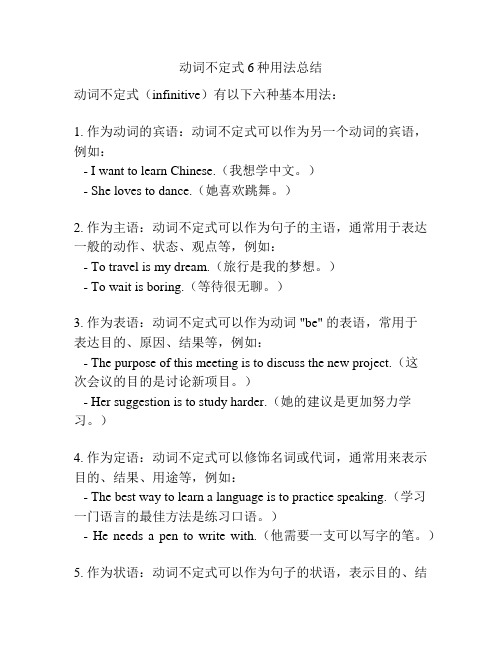
动词不定式6种用法总结动词不定式(infinitive)有以下六种基本用法:1. 作为动词的宾语:动词不定式可以作为另一个动词的宾语,例如:- I want to learn Chinese.(我想学中文。
)- She loves to dance.(她喜欢跳舞。
)2. 作为主语:动词不定式可以作为句子的主语,通常用于表达一般的动作、状态、观点等,例如:- To travel is my dream.(旅行是我的梦想。
)- To wait is boring.(等待很无聊。
)3. 作为表语:动词不定式可以作为动词 "be" 的表语,常用于表达目的、原因、结果等,例如:- The purpose of this meeting is to discuss the new project.(这次会议的目的是讨论新项目。
)- Her suggestion is to study harder.(她的建议是更加努力学习。
)4. 作为定语:动词不定式可以修饰名词或代词,通常用来表示目的、结果、用途等,例如:- The best way to learn a language is to practice speaking.(学习一门语言的最佳方法是练习口语。
)- He needs a pen to write with.(他需要一支可以写字的笔。
)5. 作为状语:动词不定式可以作为句子的状语,表示目的、结果、方式、条件等,常常与动词 "to be" 连用,例如:- She went to the supermarket to buy some groceries.(她去超市买些食品杂货。
)- He ran fast to catch the bus.(他跑得很快,以便赶上公交车。
)6. 作为补语:动词不定式可以作为某些动词的宾语补足语,常用于表示目的、愿望、需求等,例如:- They made her promise to come back.(他们让她答应会回来。
动词不定式用法大全

动词不定式用法大荟萃不定式是历次大学英语四级考试必考的内容。
不定式在句子中可做主语、宾语、表语、定语、状语和宾语补语。
1)不定式做主语一般表示具体的某次动作。
「例如」To complete the 30storied building in one year was quite a difficult task.To do that implies taking responsibility.当主语较长,谓语较短时,常用it做形式主语,而将不定式放到谓语的后面。
「例如」It is important for modern young people to master at least two foreign languages.It做形式主语,不定式放在谓语动词之后常用于下列结构中:a)It is+形容词(easy,important,difficult,foolish,inconvenient,unnecessary,right,wrong……)+(for/of sb.)+不定式「例如」It is essential to reserve a table in advance of Christmas Eve. hard to put my hope .It is not easy to catch fish with your hands only.It is important for us young people to learn English and master it.b)It is+名词(a pleasure,a pity,a pleasant thing,one‘s duty,an honor,a shame,a crime,no easy job……)+不定式It is a sheer waste of time to read that kind of trash.It is a pity to have to go without her.It is a glorious death to die for the people.c)It takes (sb.)some time (hours,months,days,a lot of time,patience……)+不定式It takes me three hours to learn English each day.It took them half the night to get home in the snow.2)不定式作表语不定式作表语常表示将来的动作,主语常常是表示意向、打算、计划的词,如wish,idea,task,purpose,duty,job等。
动词不定式的用法大全

动词不定式的用法大全今天一起学习动词不定式的用法大全?快来一起学习吧。
下面就和大家分享,来欣赏一下吧。
动词不定式的用法大全一、动词不定式是什么?简单来说:to do,非谓语动词形式之一二、位置?须位于被其修饰的名词或代词之后如:Is this the best way to help him?三、作用?具有名词,形容词,和副词的作用四、在句中可做的成分?除了不可做谓语外,其他成分都可以充当如:主语,宾语,定语,表语,宾补,状语(目的,结果,原因)例句:1.To see is tobelieve.眼见为实/百闻不如一见。
(做主语)2. I wish to be sentto work in the country. (做宾语)3. Can you tell me which is the car to be repaired (做定语)4. My work is to clean the room every day. (做表语)5. He went to the hospital to be examined . (做目的状语)6. I don’t think it rightto do it that way. (做宾补)注意:英语中为了避免头重脚轻(说白了就是平衡句子结构的需要),往往to do一般用it作形式主语(It+be+形容词/名词词组+to do sth/ that)如:To help each other is good. =It is good to help each other .这句话的主语是老师标紫色的字体。
五、不定式的用法1.不定式常可用来修饰人也可以修饰物,表示已经将要发生的动作。
如:(1)He was the first guest to arrive. 他是第一个到达的客人。
(2)He was a brave man to do what he did.他是个勇者才有这样的行为。
动词不定式的用法
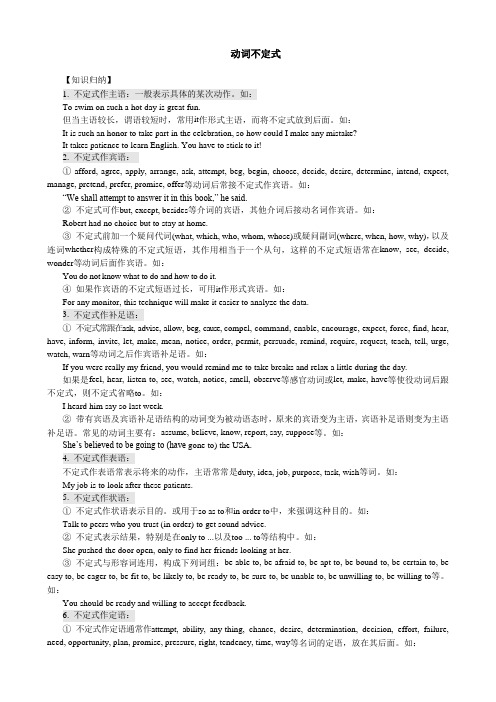
动词不定式【知识归纳】1. 不定式作主语:一般表示具体的某次动作。
如:To swim on such a hot day is great fun.但当主语较长,谓语较短时,常用it作形式主语,而将不定式放到后面。
如:It is such an honor to take part in the celebration, so how could I make any mistake?It takes patience to learn English. You have to stick to it!2. 不定式作宾语:① afford, agree, apply, arrange, ask, attempt, beg, begin, choose, decide, desire, determine, intend, expect, manage, pretend, prefer, promise, offer等动词后常接不定式作宾语。
如:“We shall attempt to answer it in this book,” he said.②不定式可作but, except, besides等介词的宾语,其他介词后接动名词作宾语。
如:Robert had no choice but to stay at home.③不定式前加一个疑问代词(what, which, who, whom, whose)或疑问副词(where, when, how, why),以及连词whether构成特殊的不定式短语,其作用相当于一个从句,这样的不定式短语常在know, see, decide, wonder等动词后面作宾语。
如:You do not know what to do and how to do it.④如果作宾语的不定式短语过长,可用it作形式宾语。
如:For any monitor, this technique will make it easier to analyze the data.3. 不定式作补足语:①不定式常跟在ask, advise, allow, beg, cause, compel, command, enable, encourage, expect, force, find, hear, have, inform, invite, let, make, mean, notice, order, permit, persuade, remind, require, request, teach, tell, urge, watch, warn等动词之后作宾语补足语。
动词的不定式用法

动词的不定式用法
1. 嘿,你知道吗,动词不定式可以用来表示目的呀!就像“我去超市买东西”,这里的“买东西”就是动词不定式,表明我去超市的目的呢。
2. 哇塞,动词不定式还能用来作宾语补足语呀!比如“妈妈让我去洗手”,“去洗手”这不定式就是补充说明“我”要做的事情,这不是很神奇吗!
3. 哎呀呀,当你想要表达一种未发生的事情时,也可以用动词不定式呢!像“明天我要去看电影”就是典型的例子呀,还不有趣?
4. 嘿,动词不定式也能在一些固定短语里出现呢!“have nothing to do”,这不就是嘛,简单明了。
5. 哇哦,你想想看,“想要做某事”,这里面就有动词不定式呀,它就是这样无处不在呢!
6. 哟呵,有时候描述一个人的能力也能用动词不定式呀,“他能跑得很快”,“跑得很快”就是不定式,多有意思呀!
7. 哈哈,动词不定式还可以用来表达原因呢!就好像“他很高兴去参加聚会”,“去参加聚会”就是他高兴的原因呢!
总之,动词不定式的用法真是丰富多彩呀,我们在日常交流和写作中可少不了它呢!。
- 1、下载文档前请自行甄别文档内容的完整性,平台不提供额外的编辑、内容补充、找答案等附加服务。
- 2、"仅部分预览"的文档,不可在线预览部分如存在完整性等问题,可反馈申请退款(可完整预览的文档不适用该条件!)。
- 3、如文档侵犯您的权益,请联系客服反馈,我们会尽快为您处理(人工客服工作时间:9:00-18:30)。
动词不定式用法大全英语动词的非谓语形式为三种:动词不定式、动名词和分词。
非谓语动词没有人称和数的变化。
动词不定式是一种非谓语动词形式,其结构为“to+动词原形”,其中to 不是介词,而是动词不定式的符号,称为小品词,动词不定式没有人称和数的变化。
动词不定式和其后面的名词等构成不定式短语,在句子中可以用作主语、表语、宾语、补足语、定语、状语等。
一. 作主语例如:To be a doctor is hard. 做医生很难。
To learn English well is not easy. 学好英语不容易。
To say is to believe.眼见为实。
动词不定式(短语)作主语时,为了避免句子的头重脚轻,可以用“it”作形式主语,而把真正的主语--动词不定式(短语)放在句子的后部。
例如上面的句子可以表示为:It is hard to be a doctor.It is not easy to learn English well. 再如:It’s important to plant trees in spring.如果动词不定式的动作是谁做的,可以在动词不定式前面加一个由介词for引导的短语,称为不定式的复合结构。
例:It’s good for us to read English aloud in the morning.对我们来说每天早晨大声读英语是很有益的。
It is important for students to use English every day.对学生来说每天使用英语是很重要的。
二. 作表语:(在形式上,位于系动词后的就是表语。
从含义上讲,表语是回答主语“是什么”或“怎么样”的语法成分。
)动词不定式(短语)作表语常用于系词be的后面。
例:His work is to drive a car. 他的工作是开车。
My job is to feed animals. 我的工作是饲养动物。
Her ambition is to be a doctor. 她的理想是当医生。
三. 作宾语动词不定式(短语)可以放在一些动词后面用作宾语,能以动词不定式作宾语的动词有:begin, start, want, forget, remember, show, learn, like, hate, love, ask等。
例:I want to tell you a story. 我想给你讲个故事。
They begin to work at eight every morning. 他们每天早晨8点开始工作。
Don’t forget to lock the door.别忘了锁门。
Would you like to go and have a picnic with us tomorrow?明天和我们一起去野餐好吗?*如果and连接两个动词不定式,第二个动词不定式一般省“to”例:(1)He wants to go and have a swim with us. 他想和我们一起去游泳(2)若作宾语的动词不定式(短语)很长,可用it作形式宾语。
I find it interesting to learn English with you. 我觉得和你一起学英语很有趣。
He found it hard to catch up with others.他觉得赶上别人很困难。
四. 作宾语补足语。
例如:The teacher asked us to read English for half an hour in the morning.老师让我们早晨读半小时英语。
The teacher often tells Jim not to spend too much time playing computer games.老师常告诉Jim不要花太多时间玩电脑游戏。
Please let me help you.让我来帮助你。
动词不定式作宾语补足语,表示宾语所做的动作,可以用动词不定式作宾语补足语的动词有:tell, ask, want, like, invite, encourage, help等。
但在let, make, see, watch, hear, feel, notice, have等感官听觉动词或使役动词后面作宾语补足语的动词不定式一般要省略动词不定式符号“to”,可以归纳为以下三种句式:1.不可以省to的不定式作宾语补足语:tell /ask / want / would like / wish / like / invite /encourage /teach sb. to do sth.例:The teacher told us to come earlier tomorrow.I want you to go now. 我想让你现在就走。
Her parents wish her to be a teacher.她父母亲希望她当老师。
2.省“to”的不定式作宾语补足语:Let / make / have sb. do sth.Let the boy go out now. 让那个男孩出去。
The boy made the baby cry. 男孩弄哭了这个小孩。
see / watch / hear / notice / feel sb. do sth.I saw the students play basketball on the playground yesterday.昨天我看见学生们在操场打篮球。
I often hear the girl sing in the next room. 我经常听到女孩在隔壁唱歌。
3.可省可不省的:help sb. (to)do sth.I often help my mother (to)do housework.我经常帮妈妈做家务。
*动词不定式的否定式是直接在to之前加not. 例:(1)Tell them not to play football in the street.告诉他们不要在街道上踢足球。
(2)省to的动词不定式的否定式是直接在动词前面加not. 例:Let the boy not go. 让那个男孩别走。
(3)如果将主动语态变为被动语态时,作宾语补足语的动词不定式变为主语补足语,动词不定式则不省“to”,即原来省的再加上,例:The boy made the baby cry.The baby was made to cry by the boy.那个孩子被男孩弄哭了。
五. 动词不定式作定语动词不定式作定语常用来修饰名词或不定代词,放于所修饰的词后,为后置定语。
例:Who was the first one to arrive? 谁第一个到的?She has no paper to write on? 她没有纸写字?The best way to learn English is to use it. 学英语最好的方法是使用它。
When is the best time to plant vegetables?什么时候是种植蔬菜的最好时间?Do you have something to drink? 你这有喝的吗?*动词不定式(短语)作定语修饰名词时,与其所修饰的词具有一种动宾关系,如果不定式中的动词为不及物动词时,其后应加上一个含义上所需要的介词。
例:I have no chair to sit on.我没有椅子坐。
He has no house to live in.他没有房子住。
六. 动词不定式作目的状语:动词不定式作目的状语常用在go, come, hurry等不及物动词后,表目的。
He went to see his sister yesterday.他昨天去看妹妹了。
They got up early to catch the early bus.他们早起去赶早班车。
有时可以把不定式(短语)提前,放于句首,表示强调目的。
例:To early English quickly and well, he went to England.为了更快更好地学英语,他去了英国。
不定式做状语,可表示动作的目的、结果、原因、条件和方式。
A. 表目的表目的时,不定式可放在句子的前面也可放在句子的末尾。
但在句子前面时,不定式常与句子用逗号隔开;而在句子末尾时一般不用逗号隔开。
如:To get there on time, we set out at five in the morning. 为了按时到达那儿,我们早晨五点就出发了。
He goes there to enjoy the fresh air. 他去那儿享受那儿的新鲜空气。
比较:to do, in order to do, so as to do都可表示目的,但to do, in order to do的位置既可在句首,又可在句末;而so as to do只能在句末---In order to build a house, he bought some wood and steel yesterday.—He bought some wood and steel yesterday in order to build a house.---He bought some wood and steel yesterday so as to build a house. 为了建房,昨天他买来了木料和钢材。
B. 表结果不定式在下列结构中表示谓语动作的结果,不定式的位置一般在句子末尾。
(1) 表示终结性的动词find, see, hear, learn, discover的不定式,常表示出乎意料的结果,并且,不定式前常有never, only等副词修饰。
如:I hurried to the railway station yesterday, (only) to find that the train had left. 昨天我急急忙忙赶到火车站时,发现火车已经开走了。
I went to the classroom, to discover it empty. 我走到教室,结果发现教室是空的。
(2) 在“so + adj. / adv. + as + to do”中。
如:The scenery is so beautiful as to attract many people here every year. 景色非常美,每年都要吸引很多人来这里。
(3) 在“adj. / adv. + enough + to do”中。
如:He ran fast enough to catch up with Li Lei. 他跑得很快,结果赶上了李蕾。
